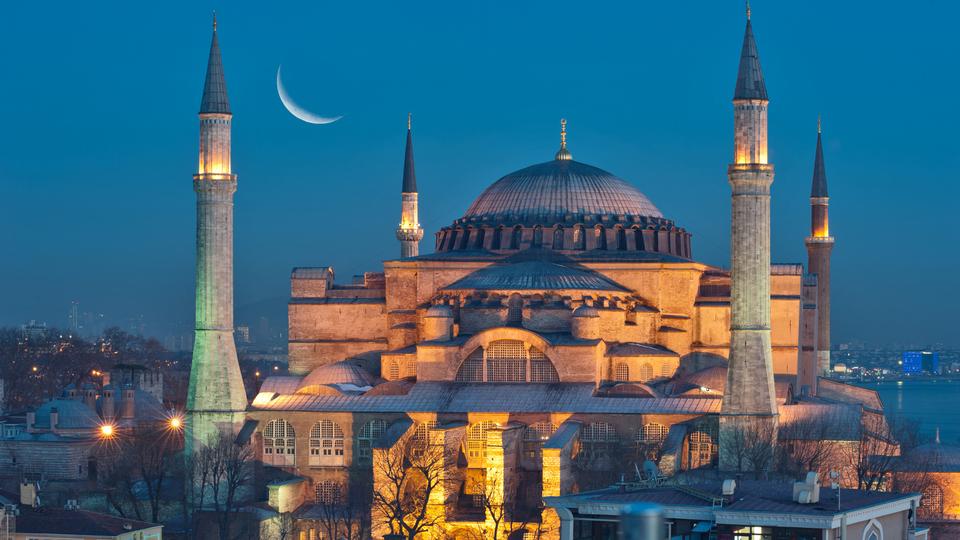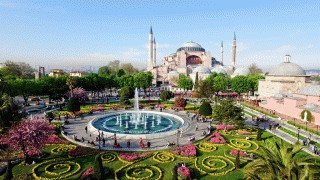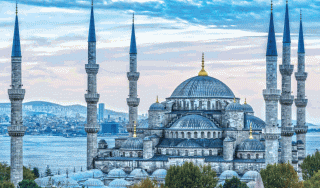- 2023
- 02
- Jan
Hagia Sophia, a historic Byzantine building in Istanbul and one of the most important landmarks in the world, is also known as the Church of the Holy Wisdom or the Church of the Divine Wisdom. It was built in the sixth century CE (532-537) as a Christian church under the direction of Byzantine Emperor Justinian I. Through the years, it has served as a mosque, a museum, and a mosque once again. The minarets and inscriptions of Islam, as well as the beautiful mosaics of Christianity, illustrate the theological transformations that have occurred in the region throughout the years.
"The proportions of Hagia Sophia are difficult for any construction not composed of steel," Helen Gardner and Fred Kleiner wrote in their book "Gardner's Art Through the Ages: A Global History." "It is approximately 270 feet [82 meters] long and 240 feet [73 meters] broad in the plan. The dome is 108 feet [33 meters] in circumference, with a crown that rises 180 feet [55 meters] above the ground."
It has functioned as a church, mosque, and now a museum during its 1,400-year history. Constantinople was the capital of the Byzantine Empire when it was built. This officially Christian state initially constituted the eastern part of the Roman Empire and continued until Rome's destruction.
Facts
There is so much to say about Hagia Sophia, but what are the most incredible facts about this wonderful structure? The following are some of the most essential facts regarding the Hagia Sophia Mosque:
- In Istanbul, there are hundreds of Roman structures dating from various eras. However, Hagia Sophia is Istanbul's oldest structure, dating back to the 6th century. Other church buildings predate the Hagia Sophia, but the Hagia Sophia is the one in the greatest shape today.
- Hagia Sophia was constructed in only five years. According to certain documents, well over 10.000 persons labored every day to construct Hagia Sophia.
- The Hagia Sophia that stands today is the third structure built for the same purpose. The earliest Hagia Sophia dates back to the fourth century, during the reign of Constantine the Great. The original Hagia Sophia, the first imperial church, was destroyed in a large fire. The original structure is no longer standing. The second Hagia Sophia was built under the reign of Theodosius the 2nd in the fifth century. During the Nika Riots, that church was demolished. The Hagia Sophia that we see now was built in the sixth century. The foundation of the second church and the columns that originally adorned it may be seen in the Hagia Sophia Mosque's garden today, out of the first two buildings.
- In the sixth century, the Hagia Sophia dome was the largest. However, it was not only the largest dome but also the only one of its kind. It is now the world's fourth-biggest dome.
- Christians began praying in a recognized church at the Hagia Sophia for the first time ever throughout the territory of the Roman Empire. As a result, Hagia Sophia is the earliest church recognized by the Roman Empire. The Friday noon prayer is the most significant prayer of the week, according to Islam. The Hagia Sophia is the oldest mosque in Istanbul's Old City since the Sultan chose it as the location for the first Friday prayer.
History
According to legend, Constantine I ordered the construction of the first church on the site of the Hagia Sophia in 325 on the ruins of a pagan temple. Constantius II, his son, dedicated it in 360. It was damaged in 404 by a fire that broke out during a riot after St. John Chrysostom's second exile as the patriarch of Constantinople. Constans I, the Roman emperor, renovated and expanded it. The cathedral was burned down again during the Nika insurgency in January 532, giving Justinian I the chance to imagine a magnificent successor.
The resulting Hagia Sophia was finished in 537 CE after a remarkable six-year construction period. Unlikely for the time period, the names of the building's architects—Anthemius of Tralles and Isidorus of Miletus—are well known, as is their knowledge of mechanics and mathematics. The current construction is basically the 6th-century edifice, but an earthquake in 558 caused a partial collapse of the dome (repaired in 562) and two subsequent partial collapses, after which it was reconstructed to a lower size and the entire church reinforced from the outside. It was rebuilt in the mid-14th century. It was the Cathedral of the Ecumenical Patriarchate of Constantinople for almost a millennium. It was sacked by Venetians and Crusaders during the Fourth Crusade in 1204.
Mehmed II had it repurposed as a mosque after the Turkish invasion of Constantinople in 1453, with the installation of a wooden minaret (on the exterior, a tower used for the call to prayer), a magnificent chandelier, a mihrab (niche denoting the direction of Mecca), and a minbar (pulpit). The crimson minaret on the southeast corner of the edifice was built by him or his son Bayezid II. The old wooden minaret was destroyed. Bayezid II built the thin white minaret on the mosque's northeast corner.
Turkish President Kemal Atatürk secularised the structure in 1934, and it became a museum in 1935. The Hagia Sophia was named a component of the Historic Areas of Istanbul UNESCO World Heritage site in 1985, together with the city's other important historic structures and places. In 2020, President Recep Tayyip Erdogan made the contentious decision to reopen the edifice as a mosque. Shortly after the announcement, Islamic prayers were performed, with drapes partially hiding the building's Christian images. The Hagia Sophia, Turkey's most renowned tourist site, remained available to tourists.
Architecture
The Hagia Sophia is an entirely unique combination of a longitudinal basilica and a centered structure, with a massive 32-meter (105-foot) main dome supported on pendentives and two semidomes, one on either side of the longitudinal axis. Though Justinian's domed basilicas served as models for Byzantine design, the Hagia Sophia remained unique, and no attempt was made by Byzantine builders to replicate it.
The structure is virtually square in design, but from within, it seems rectangular, since the huge semidomes at the east and west extend the effect of the roof. The dome is supported at either end by large marble piers that rise up from three aisles that are divided by columns, each with galleries above. The finest marble was used for the columns, which were chosen for their color and diversity. Marble slabs were used to fill the lowest portions of the walls. The curtain walls (non-load-bearing external walls) above the galleries and at the foot of the dome are perforated with windows, which disguise the supports and create the appearance that the canopy floats on air in the glare of daylight.
The marble columns, like the intricately carved cornices and capitals, have survived, but the remainder of the original décor, including much of the mosaics that graced the upper sections of the walls and roof, has vanished.
Early authors characterized them all in the most flattering terms. However, enough remains to place Hagia Sophia on the world's finest structures list.
Mosaics
Art historians believe the building's exquisite mosaics to be the primary source of information on the quality of mosaic art in the 8th and 9th centuries, just after the end of the Iconoclastic Controversy. Recent years have seen the discovery of some of the church's redecoration from the second part of the ninth century. These exhibit a continuation of the early Byzantine heritage in color and technique, with a tendency for relatively strong, clear hues and effects achieved by methods like tesserae tilting and gold cube turning.
The obsession with light appears to be stronger than ever: in poorly lit areas of the vestibule and gallery, the gold ground has a high percentage of silver cubes amid the gold cubes to create sparkle. The new ground had been broken in terms of style. The tesserae, particularly in faces, are arranged in wavy lines that break up the modeling in bandlike arrangements. Linear (the representation of form via line rather than color and tone) has advanced significantly.
New characteristics are noticeable in the layout and distribution of images. The Virgin with Child rests in the apse of the Hagia Sophia, surrounded by a magnificent expanse of gold. The practice of depicting iconlike, stationary, mosaic figures alone on a gold backdrop has pre-Iconoclastic origins, but it became a dominant design concept after the 9th century.
Drawings from the nineteenth century demonstrate that the Hagia Sophia's ornamentation comprised a particular sequence of saints. Only a handful of the saints who stood in rows on the nave walls above the galleries have survived.
According to the illustrations, those in the middle zone were prophets, while those in the bottom zone were saintly bishops. Higher above, there may have been an angelic guard and, in the center of the dome, a mosaic of Christ. In other words, the arrangement of the images may have conformed to that which was being tested out at the time, specifically for the new church construction, and which was to become the approved method of decorating in the middle Byzantine churches.
Present Day Museum
The Turkish government secularised the Hagia Sophia and converted it into a museum in 1934. According to the Turkish Council of Ministers, "owing to its historical significance, the conversion of the (Hagia Sophia) mosque, a unique architectural masterpiece of art located in Istanbul, into a museum will gratify the entire Eastern world and allow mankind to gain a new institution of knowledge."[From Robert Nelson's 2004 book, "Hagia Sophia: 1850-1950: Holy Wisdom Modern Monument.]"
The Hagia Sophia is today a popular tourist destination in Istanbul, thanks to ongoing research, repair, and restoration efforts. It is a location that has influenced the development of the city's culture throughout history.
Popular Tourist Destination
We wouldn't be incorrect if we said Hagia Sophia is one of Turkey's most visited sites. It contains amazing historical and design details. The Hagia Sophia is not just a popular tourist destination in Istanbul; it is also one of the world's oldest, largest, and most significant religious monuments. Hagia Sophia is a remarkable location. It is situated in the center of Sultanahmet and will give you a memorable experience.
The magnificent Hagia Sophia (Aya Sofya in Turkish) has a history as complicated as Istanbul itself. The major purpose of this landmark monument was altered in 2020, and it was restored to being a functional mosque under the new official name of the Hagia Sophia Holy Grand Mosque (Aya Sofya-i Kebir Cami-i Serif).
Its dome is one of the city's defining emblems, and despite all of Sultanahmet's (Istanbul's old city district) architectural features, this historic monument is still among the city's most popular tourist attractions.
If you want to discover the most creative attractions in Turkey then Hagia Sophia is the best option.
- tag:
- Turkey




